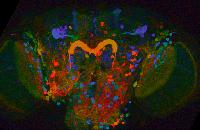 David Deitcher, Cornell University
David Deitcher, Cornell University"What Can Drosophila Tell us about the Human Language Gene FOXP2"
 David Deitcher, Cornell University
David Deitcher, Cornell University
"What Can Drosophila Tell us about the Human Language Gene FOXP2"
Department Seminar Series
4:00 p.m.
CNS 112
View the announcement here. (PDF)
Refreshments served at 3:45, 1st floor CNS foyer. Bring your mug. Reduce, Reuse, Recycle.
Individuals with disabilities requiring accommodations should contact Nancy Pierce at 274-3161.
We ask that requests for accommodations be made as soon as possible.
~~~~~~~~~~~~~~~~~~
FOXP2 is a transcription factor necessary for proper speech and language development in humans. In mice, FoxP2 mutants have altered pup cries and motor skill and CNS defects. Drosophila melanogaster has a homolog of the human FOXP2 gene — DmFoxP, but its function is unknown. Male Drosophila produce a courtship song as part of the mating process. We wondered if the genetic basis of the courtship song is related to language development in humans. In order to establish Drosophila as a model system for the study of human FOXP2 function, we studied the behavioral effects of RNAi mediated DmFoxP knockdown, and identified the expression pattern of DmFoxP in adult and larval CNS.
Knockdown of DmFoxP produced deficits in a wide variety of adult behaviors, including courtship, locomotion, and flight. Adult males show a greater deficit than females in these assays, suggesting a sex-specific aspect of DmFoxP function. This male-specific effect, however, was not seen in larval locomotion. Utilizing a DmFoxP-Gal4 line and a UAS-CD8GFP reporter line, we visualized the expression pattern of DmFoxP in the adult and larval CNS. A relatively small number of neurons are labeled in distinct clusters in the brain and thoracic ganglion, including very strong labeling of the protocerebral bridge – part of the central complex, which has previously been implicated in several sensory motor integration. This work suggests that the fly may be a useful invertebrate model to study the vital but still poorly understood function of human FOXP2.
https://www.ithaca.edu/intercom/article.php/20120127111922457